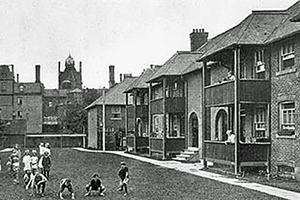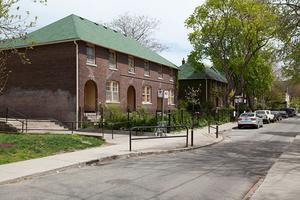This article is from our Toronto Feature series. Features from past programs are not updated.
This content is from a series created in partnership with Museum Services of the City of Toronto and Heritage Toronto. We gratefully acknowledge funding from the Ontario Ministry of Tourism, Culture and Sport, and the Department of Canadian Heritage.
Toronto Feature: Spruce Court
"Comfortable Homes Built for Low-Income Tenants"
In 1913, a group of concerned citizens responded to the need for rental housing for lower-income families near the industrial heart of Toronto. Frank G. Beer, a clothing manufacturer, sold the idea of housing reform to other business leaders, which resulted in the Canadian Manufacturer's Association, the Toronto Board of Trade, the Guild of Civic Arts, the Local Council of Women and the Toronto City Council joining to form the Toronto Housing Company. The company constructed the Sumach Street Terraces - later known as Spruce Court - Toronto's first experiment in social housing.
The Housing Company's commitment to quality was apparent from the start. It hired Eden Smith, a distinguished architect, to design the two- and three-storey buildings in his signature English Cottage style, a romantic combination of steep shingled roofs, broad eaves, tall chimneys, half-timbered gables, and large-roofed verandas. The resulting complex, 78 flats in all, projected an image of country life that reflected the influence of the Garden City movement. Apartment blocks were built around grassy courtyards for children's playcourts, to which each flat had its own door, avoiding the stigma of "tenement" housing.
The buildings were notable for their high quality construction enhanced by sturdy and enduring building materials. The doors were solid wood, with heavy brass hardware. Inside, hardwood floors and stairs, decorative mouldings and plaster walls showed a rare respect for the working class tenants. Spruce Court was an immediate success. It is now owned by its residents as the Spruce Court Cooperative.

 Share on Facebook
Share on Facebook Share on X
Share on X Share by Email
Share by Email Share on Google Classroom
Share on Google Classroom



